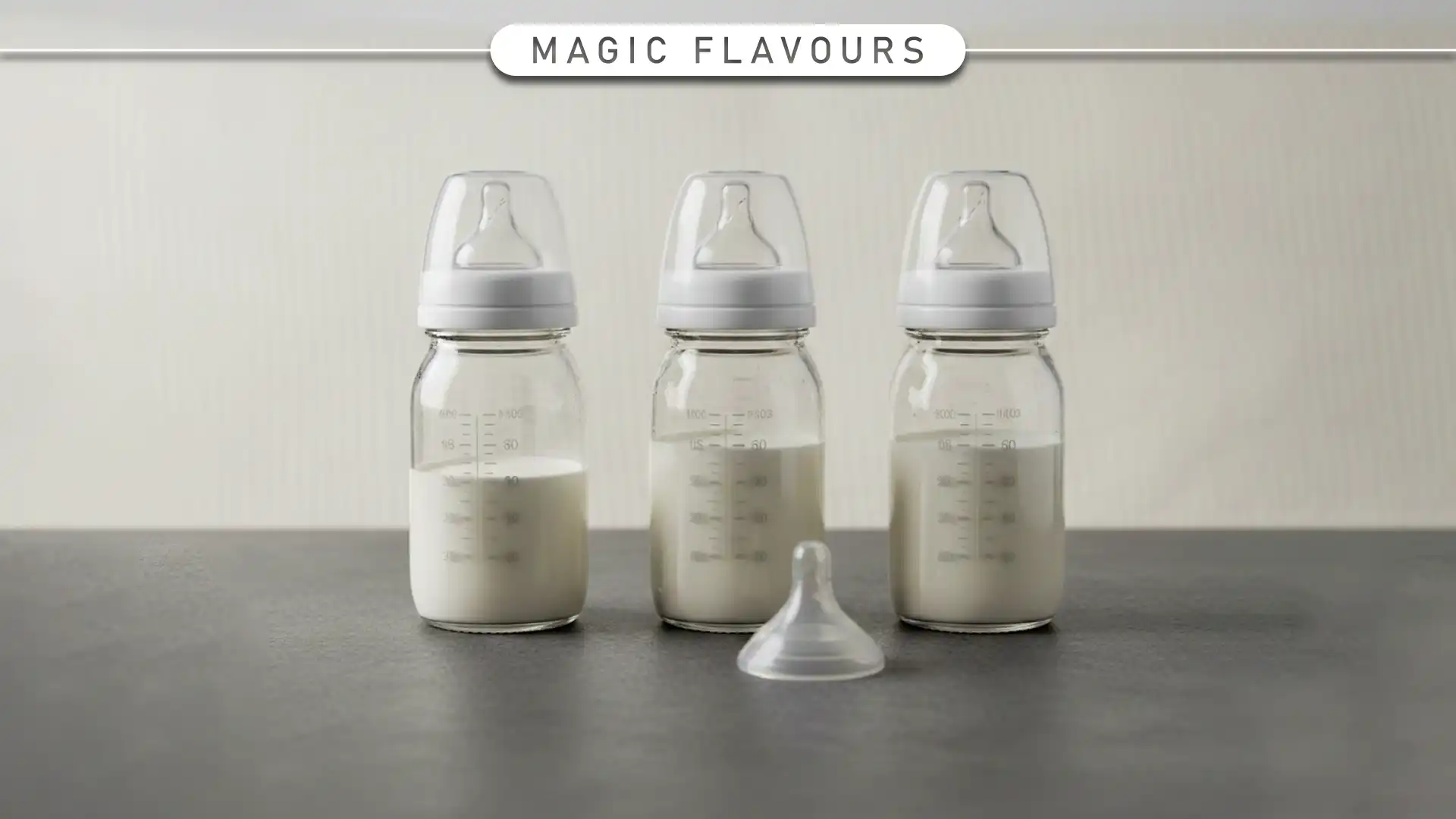1. Introduction: Understanding Human Milk
Why humans have milk beyond nutrition
Human milk delivers essential nutrients, antibodies, and hormones. Moreover, it supports infant growth, immunity, and brain development. Therefore, milk is more than just food; it is a critical biological and developmental tool.
The curiosity about its taste and sensory experience
Many people wonder how human milk tastes. It is naturally sweet, creamy, and slightly variable in flavor. In addition, understanding taste helps explain why infants respond positively to breastfeeding and how flavors influence early food preferences.
Importance of understanding milk flavor in science and culture
Studying human milk flavor informs science, healthcare, and culture. For example, it guides formula development and maternal nutrition advice. Furthermore, it connects biology with social perceptions, traditions, and infant feeding practices.
2. The Chemistry of Human Milk Flavor
Key components: lactose, fats, proteins, and hormones
Human milk contains lactose, fats, proteins, and hormones. Moreover, each component contributes to nutrition and flavor. Lactose provides natural sweetness, while fats add creaminess and mouthfeel. Proteins and hormones subtly influence taste and aroma. Therefore, milk’s composition creates a unique, complex flavor profile.
How fatty acids and sugars influence sweetness and creaminess
Fatty acids contribute smooth, creamy notes, while lactose gives a gentle sweetness. In addition, other minor sugars and lipids create subtle layers of flavor. As a result, it is naturally palatable and comforting for infants. Flavor intensity may vary slightly between mothers and over time.
Impact of maternal diet and lifestyle on taste

A mother’s diet and lifestyle can alter milk flavor. For example, consuming fruits, vegetables, or spices may slightly change sweetness or aroma. Moreover, alcohol, smoking, or medications can affect taste perception. Therefore, maternal choices can influence the sensory experience for the infant.
3. Sensory Profile: How Human Milk Tastes
Natural sweetness and mild creaminess
it is naturally sweet and mildly creamy. Moreover, lactose provides gentle sweetness that is easy for infants to accept. The fat content adds a soft, smooth texture. As a result, the combination creates a comforting and palatable flavor.
Subtle variations: slightly nutty, grassy, or even metallic notes
Human milk can have subtle variations in taste. Some describe hints of nuttiness, grassiness, or even metallic notes. These differences depend on diet, genetics, and time of day. Furthermore, minor flavor shifts are normal and generally not unpleasant.
Temperature and freshness effects on flavor perception

Temperature and freshness influence milk flavor perception. Fresh, cool milk tastes sweeter and cleaner, while warmed milk can taste richer and creamier. Moreover, milk stored for longer periods may develop slight changes in aroma or taste. Therefore, handling and temperature affect the sensory experience.
4. Cultural and Historical Perspectives
How different cultures view and describe human milk
Human milk is valued differently across cultures. In many societies, it symbolizes nourishment, care, and maternal love. Moreover, descriptions of its taste often reflect local language and culinary references. Therefore, cultural context shapes how milk flavor is perceived and discussed.
Traditional uses beyond infant feeding

Historically, some cultures used human milk beyond feeding infants. For example, it was applied in folk remedies or beauty treatments. In addition, it occasionally appeared in culinary experiments or medicinal practices. As a result, it has had diverse roles beyond nutrition.
Taboo and fascination in modern society
Human milk continues to evoke curiosity and taboo today. While breastfeeding is widely accepted, tasting or sharing milk is often stigmatized. However, scientific research and media discussions have increased fascination. Therefore, milk occupies a unique space between cultural norm and intrigue.
5. Comparison with Other Milks
Human milk vs. cow, goat, and plant-based milks
Human milk differs from cow, goat, and plant-based milks. It contains unique sugars, fats, and proteins tailored for infants. Moreover, its composition supports digestion and nutrient absorption better than other milks. Therefore, it is biologically specialized for human infants.
Differences in sweetness, fat content, and texture

Human milk is naturally sweeter and lower in protein than cow or goat milk. In addition, its fat content provides mild creaminess, while plant-based milks often vary in sweetness and texture. As a result, flavor and mouthfeel are distinct and optimized for infant palatability.
Why human milk is uniquely suited for infants
It is designed for infant growth and immune protection. Moreover, its flavor encourages acceptance and feeding efficiency. Therefore, it supports both nutrition and early sensory development in ways no other milk can fully replicate.
6. Factors That Influence Taste
Maternal diet: fruits, vegetables, spices, and herbs
A mother’s diet can subtly change milk flavor. Consuming fruits, vegetables, spices, and herbs influences sweetness, aroma, and taste notes. Moreover, repeated exposure to certain flavors may help infants develop early food preferences. Therefore, diet plays a key role in sensory variability.
Health and hydration

Maternal health and hydration affect milk taste. Well-hydrated mothers produce milk that tastes fresher and more balanced. In addition, illnesses or metabolic changes can slightly alter flavor. As a result, maintaining health supports consistent sensory quality.
Medications, alcohol, and smoking
Certain medications, alcohol, or smoking can impact milk flavor. Alcohol may add a bitter note, while smoking can introduce smoky or metallic hints. Moreover, some drugs can subtly change sweetness or aroma. Therefore, lifestyle choices influence the taste experience for the infant.
7. Scientific Studies on Human Milk Flavor
Research on taste variability among mothers
Studies show this flavor varies among mothers. Differences are influenced by diet, genetics, and health. Moreover, sugar and fat content can fluctuate over time. As a result, milk taste is not uniform and reflects maternal individuality.
How infants respond to flavor differences
Infants are sensitive to subtle changes in milk flavor. They may prefer sweeter or creamier milk and adjust sucking patterns accordingly. In addition, exposure to varied flavors can enhance acceptance of new foods later. Therefore, milk taste plays a role in early feeding behavior.
Studies on flavor learning and preference in babies

Research suggests infants learn flavor preferences through breast milk. Repeated exposure to certain tastes helps shape future food choices. Moreover, flavors experienced in utero or via milk may increase willingness to try similar foods. As a result, human milk supports both nutrition and early sensory learning.
8. Myths and Misconceptions about Human MFilk
Debunking myths about human milk taste
Many myths exaggerate or misrepresent human milk flavor. Some suggest it is overly sweet, sour, or unpleasant. However, research shows it is naturally sweet, mildly creamy, and variable. Therefore, these myths often distort reality.
Common misunderstandings in media and pop culture
Media and pop culture sometimes sensationalize human milk taste. For example, exaggerated descriptions or tabloid stories can create stigma. Moreover, misinformation can shape public perception incorrectly. As a result, accurate knowledge is essential for understanding milk flavor.
Clarifying nutrition vs. flavor
Human milk provides both nutrition and flavor, but they are distinct. Nutrients like fats, proteins, and lactose support growth, while flavor influences taste experience. Furthermore, maternal diet affects taste more than nutritional content. Therefore, understanding flavor helps separate sensory perception from health benefits.
9. Applications and Relevance of Human Milk
Breast milk flavor in formula development
Understanding human milk flavor guides formula development. Manufacturers aim to replicate sweetness, creaminess, and aroma. Moreover, mimicking natural flavor improves infant acceptance and feeding efficiency. Therefore, milk taste research directly supports product design.
Research on maternal diet and flavor exposure

Studies on maternal diet highlight how flavors transfer to milk. Consuming fruits, vegetables, and spices exposes infants to diverse tastes. In addition, repeated exposure may shape food preferences later in life. As a result, diet-based flavor research informs both nutrition and sensory science.
Implications for infant feeding and health
Milk flavor affects infant feeding behavior and growth. Infants respond positively to familiar and pleasant tastes, promoting effective nutrition. Furthermore, early flavor exposure can reduce feeding difficulties and encourage acceptance of varied foods. Therefore, flavor knowledge has direct health and developmental relevance.
10. Conclusion: Understanding the Unique Taste of Human Milk
Recap of Human Milk characteristics and influencing factors

Human milk is naturally sweet, mildly creamy, and slightly variable. Moreover, its taste is influenced by maternal diet, health, and lifestyle. As a result, milk flavor is both consistent and adaptable, reflecting individual maternal factors.
How taste connects biology, culture, and infant experience
Milk flavor bridges biology, culture, and infant development. Infants respond to sweetness and texture, shaping feeding patterns. Furthermore, cultural perceptions influence how milk taste is described and valued. Therefore, flavor connects nutrition with social and sensory experiences.
The enduring scientific and social fascination of Human Milk
Human milk continues to fascinate scientists and society alike. Research explores taste, diet effects, and infant learning. In addition, public curiosity remains high due to cultural, historical, and biological significance. As a result, studying milk flavor offers insight into both science and human experience.
